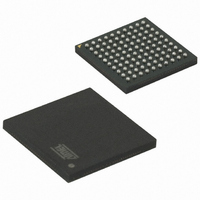ATMEGA2560V-8CU Atmel, ATMEGA2560V-8CU Datasheet - Page 42

ATMEGA2560V-8CU
Manufacturer Part Number
ATMEGA2560V-8CU
Description
IC MCU AVR 256K FLASH 100-CBGA
Manufacturer
Atmel
Series
AVR® ATmegar
Specifications of ATMEGA2560V-8CU
Core Processor
AVR
Core Size
8-Bit
Speed
8MHz
Connectivity
EBI/EMI, I²C, SPI, UART/USART
Peripherals
Brown-out Detect/Reset, POR, PWM, WDT
Number Of I /o
86
Program Memory Size
256KB (128K x 16)
Program Memory Type
FLASH
Eeprom Size
4K x 8
Ram Size
8K x 8
Voltage - Supply (vcc/vdd)
1.8 V ~ 5.5 V
Data Converters
A/D 16x10b
Oscillator Type
Internal
Operating Temperature
-40°C ~ 85°C
Package / Case
100-TFBGA
Processor Series
ATMEGA256x
Core
AVR8
Data Bus Width
8 bit
Data Ram Size
8 KB
Interface Type
2-Wire, SPI, USART
Maximum Clock Frequency
8 MHz
Number Of Programmable I/os
86
Number Of Timers
6
Maximum Operating Temperature
+ 85 C
Mounting Style
SMD/SMT
3rd Party Development Tools
EWAVR, EWAVR-BL
Minimum Operating Temperature
- 40 C
On-chip Adc
10 bit, 16 Channel
Operating Supply Voltage
1.8 V to 5.5 V
For Use With
ATSTK600-TQFP100 - STK600 SOCKET/ADAPTER 100-TQFP770-1007 - ISP 4PORT ATMEL AVR MCU SPI/JTAGATAVRISP2 - PROGRAMMER AVR IN SYSTEMATSTK503 - STARTER KIT AVR EXP MODULE 100PATJTAGICE2 - AVR ON-CHIP D-BUG SYSTEM
Lead Free Status / RoHS Status
Lead free / RoHS Compliant
Available stocks
Company
Part Number
Manufacturer
Quantity
Price
Part Number:
ATMEGA2560V-8CU
Manufacturer:
ATMEL/爱特梅尔
Quantity:
20 000
- Current page: 42 of 444
- Download datasheet (10Mb)
9.3.1
9.3.2
9.4
2549M–AVR–09/10
Low Power Crystal Oscillator
Default Clock Source
Clock Start-up Sequence
The device is shipped with internal RC oscillator at 8.0 MHz and with the fuse CKDIV8 pro-
grammed, resulting in 1.0 MHz system clock. The startup time is set to maximum and time-out
period enabled. (CKSEL = "0010", SUT = "10", CKDIV8 = "0"). The default setting ensures that
all users can make their desired clock source setting using any available programming interface.
Any clock source needs a sufficient V
cycles before it can be considered stable.
To ensure sufficient V
the device reset is released by all other reset sources.
describes the start conditions for the internal reset. The delay (t
Oscillator and the number of cycles in the delay is set by the SUTx and CKSELx fuse bits. The
selectable delays are shown in
dependent as shown in
Table 9-2.
Main purpose of the delay is to keep the AVR in reset until it is supplied with minimum Vcc. The
delay will not monitor the actual voltage and it will be required to select a delay longer than the
Vcc rise time. If this is not possible, an internal or external Brown-Out Detection circuit should be
used. A BOD circuit will ensure sufficient Vcc before it releases the reset, and the time-out delay
can be disabled. Disabling the time-out delay without utilizing a Brown-Out Detection circuit is
not recommended.
The oscillator is required to oscillate for a minimum number of cycles before the clock is consid-
ered stable. An internal ripple counter monitors the oscillator output clock, and keeps the internal
reset active for a given number of clock cycles. The reset is then released and the device will
start to execute. The recommended oscillator start-up time is dependent on the clock type, and
varies from 6 cycles for an externally applied clock to 32K cycles for a low frequency crystal.
The start-up sequence for the clock includes both the time-out delay and the start-up time when
the device starts up from reset. When starting up from Power-save or Power-down mode, Vcc is
assumed to be at a sufficient level and only the start-up time is included.
Pins XTAL1 and XTAL2 are input and output, respectively, of an inverting amplifier which can be
configured for use as an On-chip Oscillator, as shown in
ceramic resonator may be used.
This Crystal Oscillator is a low power oscillator, with reduced voltage swing on the XTAL2 out-
put. It gives the lowest power consumption, but is not capable of driving other clock inputs, and
may be more susceptible to noise in noisy environments. In these cases, refer to the
Crystal Oscillator” on page
Typ Time-out (V
4.1 ms
65 ms
0 ms
Number of Watchdog Oscillator Cycles
CC
= 5.0V)
CC
“Typical Characteristics” on page
, the device issues an internal reset with a time-out delay (t
44.
Table
ATmega640/1280/1281/2560/2561
CC
Typ Time-out (V
9-2. The frequency of the Watchdog Oscillator is voltage
to start oscillating and a minimum number of oscillating
4.3 ms
69 ms
0 ms
CC
= 3.0V)
“On-chip Debug System” on page 55
Figure
384.
TOUT
9-2. Either a quartz crystal or a
) is timed from the Watchdog
Number of Cycles
8K (8,192)
512
0
“Full Swing
TOUT
) after
42
Related parts for ATMEGA2560V-8CU
Image
Part Number
Description
Manufacturer
Datasheet
Request
R

Part Number:
Description:
IC AVR MCU 2.4GHZ XCEIVER 64QFN
Manufacturer:
Atmel
Datasheet:

Part Number:
Description:
Manufacturer:
Atmel
Datasheet:

Part Number:
Description:
MCU ATMEGA644/AT86RF230 40-DIP
Manufacturer:
Atmel
Datasheet:

Part Number:
Description:
BUNDLE ATMEGA644P/AT86RF230 QFN
Manufacturer:
Atmel
Datasheet:

Part Number:
Description:
BUNDLE ATMEGA644P/AT86RF230 TQFP
Manufacturer:
Atmel
Datasheet:

Part Number:
Description:
MCU ATMEGA1281/AT86RF230 64-TQFP
Manufacturer:
Atmel
Datasheet:

Part Number:
Description:
MCU ATMEGA1280/AT86RF230 100TQFP
Manufacturer:
Atmel
Datasheet:

Part Number:
Description:
BUNDLE ATMEGA1280/AT86RF100-TQFP
Manufacturer:
Atmel
Datasheet:

Part Number:
Description:
BUNDLE ATMEGA2560V/AT86RF230-ZU
Manufacturer:
Atmel
Datasheet:

Part Number:
Description:
MCU ATMEGA2561/AT86RF230 64-TQFP
Manufacturer:
Atmel
Datasheet:

Part Number:
Description:
INTERVAL AND WIPE/WASH WIPER CONTROL IC WITH DELAY
Manufacturer:
ATMEL Corporation
Datasheet:

Part Number:
Description:
Low-Voltage Voice-Switched IC for Hands-Free Operation
Manufacturer:
ATMEL Corporation
Datasheet:

Part Number:
Description:
MONOLITHIC INTEGRATED FEATUREPHONE CIRCUIT
Manufacturer:
ATMEL Corporation
Datasheet:

Part Number:
Description:
AM-FM Receiver IC U4255BM-M
Manufacturer:
ATMEL Corporation
Datasheet:











